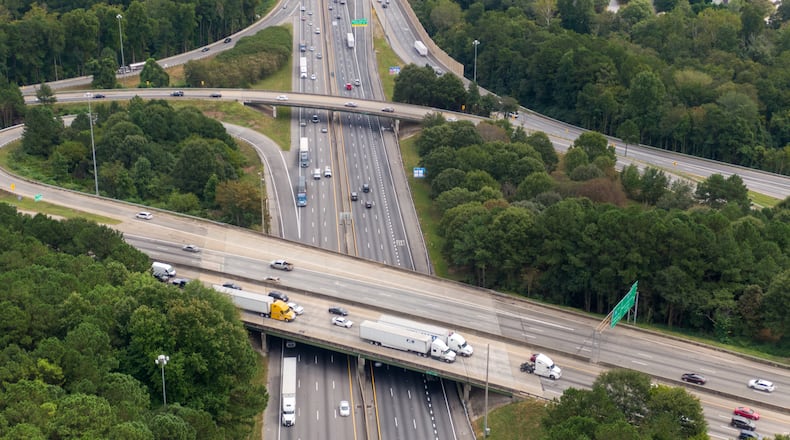State officials are moving ahead with three massive road construction projects that could shave precious minutes off the commutes of hundreds of thousands of metro Atlanta residents.
Over the next few years, the Georgia Department of Transportation will add toll lanes to a 16-mile stretch of Ga. 400 – lanes that would aid a transit expansion in north Fulton County. The agency also will rebuild I-285 interchanges at I-20 east and west of Atlanta – two of the worst freight bottlenecks in the country.
The three projects are part of a larger “major mobility investment program” that GDOT says will keep traffic moving even as the region adds millions of new residents in coming decades.
“Metro Atlanta is very congested almost every day,” said Tim Matthews, who oversees the program for GDOT. “We believe that all the projects in the program are really going to help commuters on these corridors.”
Former Gov. Nathan Deal unveiled the $10 billion program in 2016. It also includes toll lanes on the top half of the Perimeter, the widening of I-85 in Gwinnett and Jackson counties and 40 miles of trucks-only lanes south of Atlanta. Also it includes the widening of I-16 and a new I-16 interchange at I-95 in Savannah.
The construction binge was made possible by a gas tax increase approved by state lawmakers in 2015.
Plans have changed substantially since they were first unveiled. Last fall GDOT announced it was postponing several metro Atlanta projects and speeding up the truck lanes and the widening of I-85. It also split up the massive $5 billion toll lanes on the top end of I-285 into several smaller projects.
Nonetheless, several projects are advancing, and GDOT is soliciting public comments on the designs.
The Ga. 400 toll lanes have received the most attention. GDOT would build two new lanes in each direction from the North Springs MARTA station to McGinnis Ferry Road. North of that, it would build one lane in each direction to just north of McFarland Parkway in Forsyth County.
Tolls in the new lanes would depend on traffic – the worse the traffic, the higher the toll. Similar lanes across metro Atlanta have cut travel times for those willing to pay at least 10 cents a mile. But a draft environmental study found motorists in the free lanes also would save time on their commute.
The toll lanes would eventually serve a bus rapid transit line from Windward Parkway to North Springs. Matthews said the lanes will not preclude construction of a MARTA heavy rail extension in the future.
“We think it’s a win-win, not just for commuters driving their cars, but for commuters who want to use transit services as well,” he said.
The project also will have negative consequences. It would displace 45 homes and five businesses, and additional noise is a concern for many residents. Several cities along the route have expressed concerns about interchanges and other design elements. GDOT says it has tried to mitigate such concerns.
Jeff Lewis and other Sandy Springs residents opposed an initial design that would have seen new elevated lanes over Northridge Road – a design they feared would be unsightly and lead to unnecessary traffic noise. GDOT later agreed to build the lanes beneath Northridge.
But residents aren’t completely satisfied.
“I would say they have listened, and they’ve been working with the city,” Lewis said. “I would give them kudos on that. But the sound can be at unacceptable levels and they can only mitigate it so much.”
Construction is expected to begin in 2022, with the lanes open to traffic in 2026.
Construction of the new I-285 interchange at I-20 east of Atlanta would not displace any homes or businesses, though GDOT would need to acquire parts of 53 parcels, or about 22 acres.
The project would replace tight cloverleaf ramps with an extensive system of collector-distributor lanes that would allow traffic to speed through the interchange. For example, the existing one-lane I-20 westbound ramp to I-285 southbound has a speed limit of 15 mph. It would be replaced with a two-lane flyover ramp with a limit of 45 mph.
The project also includes other improvements along 2.8 miles of I-285 and 6.6 miles of I-20. Among other things, auxiliary lanes would allow traffic more time to merge.
Construction on the new interchange would begin in 2022 and end in 2025.
The I-285/I20 interchange west of Atlanta is not as far along, and GDOT has not completed a draft environmental study. But GDOT expects to acquire portions of about 125 parcels and relocate 5 homes and one business.
Like the other interchange, the I-285 west project would allow faster trip times through the interchange. And it would involve other improvements along an eight-mile stretch of I-20 and along a two-mile stretch of I-285.
Construction won’t begin until 2023 and end in 2026.
GDOT is accepting public comment on the Ga. 400 lanes through Tuesday. It’s accepting comment on the I-285 east interchange assessment through next Thursday and on the I-285 west interchange through Oct. 8.
Rebuilding your commute
More major highway construction is coming to metro Atlanta over the next few years. Here’s a look at three projects.
Ga. 400 express lanes
The project: Sixteen miles of toll lanes from the North Springs MARTA station to .9 miles north of McFarland Parkway in Forsyth County.
Cost: $1.3 billion
Public comment: Through Sept. 22
Construction begins: 2022
Open to traffic: 2026
More information: https://0001757-gdot.hub.arcgis.com
I-285/I-20 east interchange
The project: A new interchange, plus collector-distributor and auxiliary lanes along I-20 and I-285.
Cost: $543 million
Public comment: Through Sept. 24
Construction begins: 2022
Open to traffic: 2025
More information: https://0013915-gdot.hub.arcgis.com
I-285/I20 west interchange
The project: A new interchange, plus new collector-distributor and other lanes along I-20 and I-285.
Cost: $795 million
Public comment: Through Oct. 8
Construction begins:2023
Open to traffic: 2026
More information: https://0013918-gdot.hub.arcgis.com
About the Author
Featured

